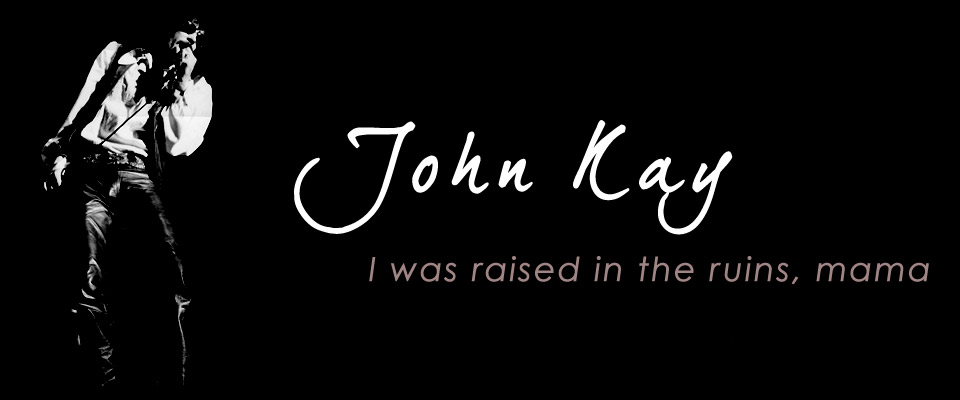The vocals of John Kay, founder and lead singer of Steppenwolf, have become a part of our popular culture for over forty years. Born to be Wild, Magic Carpet, The Pusher and a host of other works have been an important part of the soundtrack of the past several generations. However, the commanding 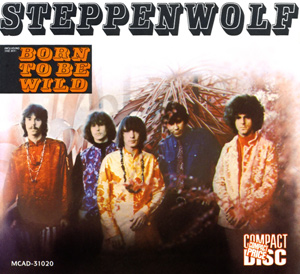 presence of the tall figure of John in black leather, with dark glasses singing Born to be Wild, gives us little understanding of what John went through to reach this level of success in the music industry.
presence of the tall figure of John in black leather, with dark glasses singing Born to be Wild, gives us little understanding of what John went through to reach this level of success in the music industry.
John’s story is an amazing odyssey that began in East Prussia during the height of World War II when John was born months after his father had died in the war, and with a eye condition called achromatopsia that would leave him visually impaired, totally colorblind and with a severe aversion to light. His path would include escaping from East Germany to West Germany, immigrating to Canada and then to the United States. It was there that he would reach international rock stardom.
The War Years
On April 12, 1944, as World War II raged, Joachim Fritz Krauledat was born in Tilsit, East Prussia, near the Lithuanian border to Elsabeth Krauledat. Two 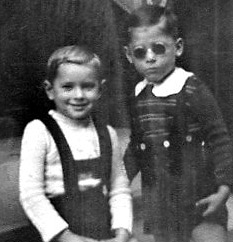 John with his dark glasses.months before he was born, his father, Fritz Krauledat, a German soldier, had been killed in the Baltic region on the Russian front. When the Russian armies began to surge towards East Prussia, Elsbeth with her infant son would flee through part of Poland to Arnstadt, Germany. Through the kindness of a local family, who opened their home to them, John and his mother would live there for the next four years. Though initially American troops arrived to secure Arnstadt, the Potsdam Agreement between the allies, required the Americans to withdraw leaving Arnstadt in the control of the Russians in what became East Germany.
John with his dark glasses.months before he was born, his father, Fritz Krauledat, a German soldier, had been killed in the Baltic region on the Russian front. When the Russian armies began to surge towards East Prussia, Elsbeth with her infant son would flee through part of Poland to Arnstadt, Germany. Through the kindness of a local family, who opened their home to them, John and his mother would live there for the next four years. Though initially American troops arrived to secure Arnstadt, the Potsdam Agreement between the allies, required the Americans to withdraw leaving Arnstadt in the control of the Russians in what became East Germany.
Vision Problems Appear
“When I was in my pram (cradle), if the sun was directly in my eyes I would cry; when she put a little sheet over the canopy to keep the sun out, I would stop crying”
- John Kay from his autobiography, Magic Carpet Ride
Within the first year of John’s life, his mother noticed nystagmus, rhythmic shaking of the eyes, and squinting in bright lighting. With no local eye care available, she traveled with her infant son to the nearby town of Erfurt to seek eye care for him. He was provided with prescription eyewear, but most importantly the doctor had the lenses tinted to help reduce his aversion to the light. An understanding of achromatopsia in the 1940s was very limited. Being a very rare condition, most eye doctors had probably never been confronted with a case.
His doctor suspected a nutritional cause and suggested that better nutrition might be helpful. In post-war East Germany, food supplies were scarce. His mother had long worried that the strain of loosing her husband during the pregnancy and limited food during the war may have caused his vision problems. John’s mother began to realize that fleeing to West Germany where food supplies were more plentiful might offer her son more help with his vision. (Ironically, though achromatopsia is a genetic disease, recent animals studies suggest that antioxidant vitamins may be helpful in achromatopsia.)
Escaping from East Germany
John’s mother worked tirelessly as a seamstress to earn money for them and to save enough money to leave East Germany. She was eventually able to pay two guides to get them across the border. When John was four years old, Elsbeth, John and his Aunt Ida crossed the border between East and West Germany.
“Pack your rucksack Joachim. We’re going on a trip.’ That was all my mother told me the night we escaped from East Germany” ….. We crossed near the Hartz Mountains south of Brunswick and Hannover. I remember seeing search lights moving, ……… As the women passed under the wire, one of our guides took me by the hand and led me through, As I crouched I could hear a commotion, then gunfire, maybe a machine gun burst. Hurry, hurry, hurry just keep running implored our guide.”
- John Kay from his autobiography, Magic Carpet Ride
Passing quickly through a refugee camp, Elsbeth, John, and Aunt Ida traveled to reach family members who had already made it into West Germany. By the end of the year, Elsbeth and John had settled in a small attic room in Hannover, a city on the Leine River in an area of rich farmland. It was during this time that his mother would remarry.
Surviving on the Playgrounds
“Next to our apartment building was an open area about the width of a soccer field. With some chalk, we drew imaginary goal posts on the sides of the buildings. I couldn’t play very well during the daylight hours, if it was very sunny because my eyes are so sensitive to the light that I had to squint even with my dark glasses on. When it got to be dusk, however, my eyes would open up.…. Then I could play soccer much better and hold my own with the other kids. “
- John Kay from his autobiography, Magic Carpet Ride
John was taunted because he did not have a father and had tricks played upon him because of his vision problems. Thus, John learned early to be tough. If a youngster mistreated him, he knew that with his poor vision he could not catch them, but he would remember and days later he would retaliate. This type of toughness was critical in the rough playgrounds of post war Germany and later in his career. It probably came from John’s mother, who never seemed to let problems stop her and always seemed to persevere despite many obstacles in her life.
The Waldorf School
John initially attended a crowded public school in war torn West Germany, which had fifty students in a classroom with two separate shifts of students. With a drastic shortage of teachers and facilities, there was no individualiz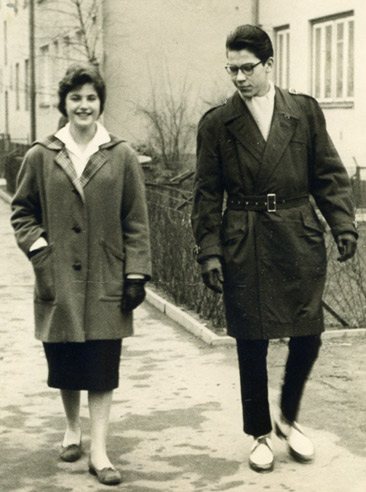 John with his cousin in West Germanyed attention for students and little to no assistance for someone with a visual impairment. John learned quickly, that if you constantly raise your hand and ask the teacher what was on the chalkboard, not only would the teacher become frustrated, but also the other students would unmercifully taunt you. It became less painful to just not ask for help even if he could not see the board. This led John to became more introverted and his grades began to drop. John’s mother realized that continuing in the crowded public schools would be disastrous for John’s future. She saw the Waldorf School as an opportunity for a smaller class size, but the school had long waiting lists to be accepted.
John with his cousin in West Germanyed attention for students and little to no assistance for someone with a visual impairment. John learned quickly, that if you constantly raise your hand and ask the teacher what was on the chalkboard, not only would the teacher become frustrated, but also the other students would unmercifully taunt you. It became less painful to just not ask for help even if he could not see the board. This led John to became more introverted and his grades began to drop. John’s mother realized that continuing in the crowded public schools would be disastrous for John’s future. She saw the Waldorf School as an opportunity for a smaller class size, but the school had long waiting lists to be accepted.
Rudolf Steiner developed the first Waldorf School, when Emil Molt, owner and manager of the Waldorf-Astoria Tobacco Company asked Steiner, an Austrian educator, with many progressive ideas on education to develop a school for their employee’s children. The Waldorf Schools embraced a holistic and humanistic approach to education. This first school was started in 1919. Hitler later banned these schools because of the broad humanistic approach to education did not conform to his views. After World War II, these schools began to reopen.
The long waiting lists to enter the Waldorf School did not deter his mother. She learned through her clients as a seamstress about a pediatrician, whose husband served on the board of directors of the school. After having the pediatrician examine John several times, she asked for and obtained help getting John into the Waldorf School from the woman’s husband.
For John, attending the Waldorf School was life changing. Though it was not a school for the visually impaired, it was a school that gave John exactly what he needed. This school gave him more individualized attention and was willing to adapt to many of his special needs. This departure from the rigid repetition drills of German public schools to a broader holistic approach to learning that also integrated the humanities, art and music fit John perfectly.
“My attitude towards school totally changed once I enrolled in the Waldorf School….. In Herr Doctor Riehn’s room, the desks were bolted to the floor, but he saw that I needed to be closer to the board so he simply brought in another desk and put it where I needed it and he would read to me directly off his paper at times. I was a happy kid in that school. The kids there accepted me. Bad eyes and all.”
- John Kay From his biography Magic Carpet Ride
A Rock ‘n’ Roll Awakening
I was raised I the ruins, mama
‘Til I was thirteen
Every day I heard the radio
Every night I had the same old dream
To sing my song
And watch my name in lights
If you wanna see your dreams come true
Honeychild, you gotta get right down and fight.
- Live Your Life 1977 - John Kay
On a homemade cigar box radio that he had traded a classmate for, John would lay in his bed at night pretending to be asleep, but all the while listening to rock and roll music on the Armed Forces Radio. The first entertainer he remembers listening to was Little Richard, and though he could not yet understand the language, the sound of rock and roll music stirred something deep inside him. He didn’t just want to listen; he wanted to play the music. Before he was thirteen years old, he began to dream of being a rock ‘n’ roll singer. And if he continued to live in West Germany, he began to fear he would be doomed to attending a trade school and his dream would die.
“ Here I was on the wrong side of the Atlantic, legally blind and speaking the wrong language. It’s still amazing to me that the dream came true.”
- John Kay, Interview
Immigrating to Canada
When John’s mother and stepfather began to discuss the idea of moving to North American, John realized this could be a step towards his dream of being a rock ‘n’ roll singer. He subtly promoted the idea as family members already in North America sent back letters of their success. To immigrate directly to the United States was not yet a possibility for most Germans, but Canada was open to their immigration. In March of 1958, shortly before his fourteenth birthday John, his mother and stepfather bravely left Hannover, West Germany to immigrate to Toronto, Canada where they would once again start over. But this time they were in a new country with a new language to learn.
Sight Saving Classes
Having left his success at the Waldorf School behind, John found his first exposure to the school system in Canada to be very difficult. The language barrier combined with his vision problems together seem difficult to overcome.
“I would eventually learn the language, though those first few months were difficult. What was insurmountable, however, was again the eyesight problem. Even though I was in the front row, I now had to decipher the hand writing of someone writing in an unusual handwriting style, in a language I didn’t understand, all from a distance I couldn’t see from. “
- John Kay, Magic Carpet Ride
John, however, was not left to flounder in regular classes. He was soon evaluated by a vision consultant to the school system, who recommended Sight Saving classes, which were held at the Deer Elementary School. Sight Saving classes were structured to provide a better environment for those with visual impairments, but not completely blind. These classes were sponsored by the Canadian National Institute for the Blind (CNIB) and are credited by John as an important bridge from his education in Germany to the Canadian Public schools. It allowed him the additional time and vision help he needed to learn English.
Learning a new language can be difficult for anyone, but the combination of impaired vision and not speaking the language would have been insurmountable in a regular classroom. As with most achromats, John could function well when light and glare were controlled and by holding things closer, he could read most print.
But perhaps one of the most important aids John received from the Canadian National Institute for the Blind was a Wollensach reel-to-reel tape recorder. He really was unsure if he needed the Talking Book Program, which is what they were offering it for, but he knew the tape recorder could be used to record music and to record his singing voice.
“She then told me that the CNIB would provide me with a Wollensach reel-to-reel tape recorder to listen to these tapes. Seeing my window of opportunity, I immediately jumped at the offer, not for the taped book but for the tape machine itself. It allowed me (may the RIAA forgive me) to tape songs from the radio and I borrowed records to tape as well.… I also started taping my first attempts at singing in English.”
- John Kay Autobiography, Magic Carpet Ride
After two years in sight saving classes, John would return to Humberside Collegiate and enroll in the 10th grade. He had lost a year, but the language barrier had been surpassed and he was ready to return. John’s colorblindness became an issue due to an interest in electronics. His complete lack of color vision would block this as a carrier path, but it kept him focused on his goal of music.
A New Name
Owing to John’s vision problems, he could not participate in most sports. At school, his gym teacher allowed him to do weight training as an alternative to the sports others played. His gym teacher would also change his first name from Joachim to John for convenience sake. His mother reported that people called her Mrs. K, because they could not pronounce her married name of Kyczinski. John would later change his legal name from Joachim Fritz Krauledat to John Kay.
Pursuing the Music Dream
“ From as far back as I remember, I always liked music.”
- John Kay
This desire to pursue music as a career began to be an obsession. By the summer of 1958, John had bought his first guitar, a $55 Kay guitar at the Simpson-Sears department store in Toronto. Stan King, a friend from Sight Saving class, loaned him a Hank Williams songbook. From this book, he learned to play cords on his Kay guitar.
Since John couldn’t participate in many activities with his peers ow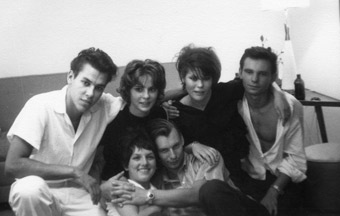 1962, Partying with friendsing to his vision problems, he became less concerned about sports and outside play in the bright uncomfortable light and began to spend much more time on his music. John credits this aspect of his achromatopsia with giving him the time to develop his musical skills.
1962, Partying with friendsing to his vision problems, he became less concerned about sports and outside play in the bright uncomfortable light and began to spend much more time on his music. John credits this aspect of his achromatopsia with giving him the time to develop his musical skills.
John’s first performance was at church camp north of Toronto in 1959. He performed an Everly Brother’s tune. John continued to seek out sources for his musical interests. He attended concerts and clubs in the Toronto area and hung out with other musicians to learn more about music.
With John’s vision problem he found learning directly by listening to other musicians was easier than any type of formal music training. He would finish his schooling, but that was less important to him than his music. He was continually listening to the radio and his records, which along with his visits to the clubs became his own personal music school.
Coming to the USA
After five years of living in Canada, his family immigrated to the United States.
I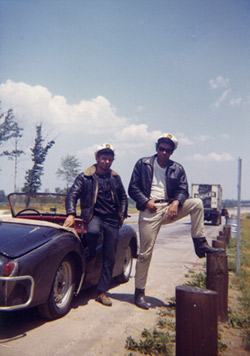 Heading for California on Route 66n April of 1963, his mother and stepfather moved to Buffalo, New York, while John stayed in Toronto until he completed his final year at Humberside Collegiate in June of 1963. John finally made it to the United States, where so much of the music he loved had come from. But his early days in the United States were less than easy.
Heading for California on Route 66n April of 1963, his mother and stepfather moved to Buffalo, New York, while John stayed in Toronto until he completed his final year at Humberside Collegiate in June of 1963. John finally made it to the United States, where so much of the music he loved had come from. But his early days in the United States were less than easy.
John was quickly welcomed by the Selective Service. The Vietnam War had begun and the draft was in place. However, John’s poor vision eliminated him from military services. He also had difficulty in getting employment because of his vision. This was long before the American Disabilities Act and employers could easily discriminate against a person with vision or other disabilities. He had to settle for working in a candle-making factory sponsored by the Buffalo Association for the Blind for 75 cents an hour. John suddenly became aware that services for the visually impaired were not as available as they had been in Canada. The music scene in Buffalo was also limited compared to Toronto.
Music Career
In Buffalo, John formed a short-lived small group called JFK and the Congressmen. He became more interested in the folk music scene, and he began to earn money performing and could see himself earning a living with music.
Inspired by the television program, Route 66, John set out with his friend, Klaus on a cross-country drive to California. Upon his return, John had decided that he would like to move to California. He was surprised to learn that his mother and stepfather had been discussing the same idea. They all agreed to move, and once again the family would start all over again.
“A month or so after my return, we sold everything worth parting with, loaded up a U-Haul trailer, got into our white 62 Chevy, and headed west. Once again the family was on the move, no simple task for two people in their fifties. For me, barely twenty years old, I was headed for my sixth home.”
- John Kay from his autobiography, Magic Carpet Ride
In California, John immersed himself in the music scene of Southern California. He became the “manager” of the New Balladeer, a small coffeehouse that featured musical and comedic performers. It was not a glamorous job; he had to be a jack-of-all-trades in the coffeehouse. But, it exposed him to many musicians and in his spare time, he attended other clubs like the Troubadour where he eventually worked as a dishwasher for the chance to watch and learn from other performers. It was a time of great change in the music; folk music was changing and the Beatles, Rolling Stones and others were altering the entire direction of music.
In 1965, John started traveling around the United States and Canada performing acoustic blues in bars and coffeehouses. By late Summer he had joined “The Sparrows” while playing in Toronto. The Sparrows would in 1966 become part of the San Francisco Bay area music scene. However in the Spring of 1967 they disbanded after an ill fated engagement in Los Angeles. It was there that a few months later, John Kay would form Steppenwolf.
Steppenwolf Arrives
After the Sparrows disbanded, John recruited two old Sparrow band mates, drummer Jerry Edmonton and keyboardist Goldy McJohn, and recruited 17-year-old guitar prodigy, Michael John with Steppenwolf 1960's Monarch and bassist, Rushton Moreve. The new band became Steppenwolf, named after Hermann Hesse's novel.
John with Steppenwolf 1960's Monarch and bassist, Rushton Moreve. The new band became Steppenwolf, named after Hermann Hesse's novel.
With John Kay’s powerful gritty vocals, the band's blues-based rock exploded upon America in the summer 1968, with "Born To Be Wild" followed in quick succession by the timeless rock anthems; "Magic Carpet Ride"; "The Pusher"; "Rock Me." and “Monster”
"Born To Be Wild" almost never happened. "Born To Be Wild" was the third single off our first album and the record company argued about which of the tunes that remained from the album, that had not been released to date, should be the next single. So management and band were on one side and the label on the other side had this tug of war and finally the compromise was to put "Born To Be Wild" on one side, put the other song that the record company preferred on the opposite side, send it to radio, and let them fight it out. Well, within a relatively short period of time (early summer of 1968) 9 out of 10 played "Born To Be Wild."
- John Kay
When the movie Easy Rider, with Dennis Hopper, Peter Fonda and Jack Nicholson was released using both “Born to be Wild” and “The Pusher”, Steppenwolf s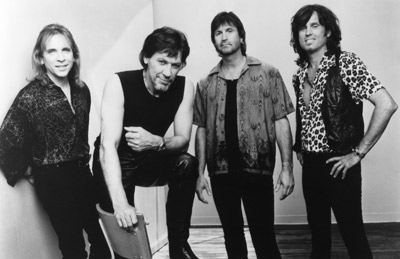 John with Steppenwolf 2000'suddenly had international recognition. The rest was rock history.
John with Steppenwolf 2000'suddenly had international recognition. The rest was rock history.
John Kay on his own and with Steppenwolf has continued to produce albums of original work. Steppenwolf, after a period of retirement, reemerged playing concerts around the world.
Today, Steppenwolf’s worldwide record sales exceed 35 million units. Its songs remain fixtures on classic-rock radio, and have been licensed for use in approximately 80 motion pictures and an even greater number of television programs. The music of John Kay and Steppenwolf has become a fixture in music history and pop culture for over 40 years. In March of 1996, John Kay was inducted into the Canadian Academy of Recording Arts and Sciences Hall of Fame.
After many years living in Los Angeles, then Nashville, and on the road, today John Kay resides in the Vancouver area with his wife, Jutta Maue Kay. They have been together since 1965 and have a grown daughter, Shawn.
Living with Achromatopsia
John uses red filtered prescription eyewear and very dark red sunglasses outside to control the light. He also finds a small pop-out magnifier helpful for spot reading of fine print. He uses a Kindle DX, a larger screen version of the popular Kindle, for reading books and newspapers. One unusual low vision aid he sometimes employs is his Canon GL-2 video camera. Despite his vision, John is a very good videographer and has learned the video camera’s 20X optical zoom can help him see in the distance. A small monocular telescope helps him read airline schedule postings and signs. In mid day bright sunlight he also at times using a special long billed baseball style cap (often sold to fishermen) that helps reduce his light and glare issues. Additionally, John has also learned to be very organized for when your vision is poor you cannot easily find a missing object or file.
outside to control the light. He also finds a small pop-out magnifier helpful for spot reading of fine print. He uses a Kindle DX, a larger screen version of the popular Kindle, for reading books and newspapers. One unusual low vision aid he sometimes employs is his Canon GL-2 video camera. Despite his vision, John is a very good videographer and has learned the video camera’s 20X optical zoom can help him see in the distance. A small monocular telescope helps him read airline schedule postings and signs. In mid day bright sunlight he also at times using a special long billed baseball style cap (often sold to fishermen) that helps reduce his light and glare issues. Additionally, John has also learned to be very organized for when your vision is poor you cannot easily find a missing object or file.
Giving Back to the World
In 2004, John and Jutta Maue Kay developed the Maue Kay Foundation, a 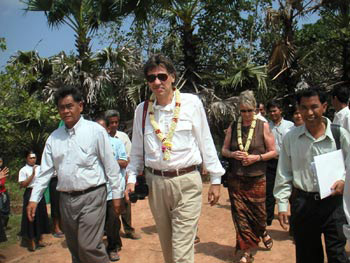 non-profit charitable foundation to support individuals and organizations engaged in the protection of wildlife, the environment and human rights. With the guidance of Bernie Krisher's "American Assistance For Cambodia", in 2004 the Maue Kay Foundation, in conjunction with the Asia Development Bank,
non-profit charitable foundation to support individuals and organizations engaged in the protection of wildlife, the environment and human rights. With the guidance of Bernie Krisher's "American Assistance For Cambodia", in 2004 the Maue Kay Foundation, in conjunction with the Asia Development Bank,  co-sponsored the building of The Tith Mom School in Takeo Province, Cambodia. Additionally their foundation supports a variety of projects in Africa and Asia.
co-sponsored the building of The Tith Mom School in Takeo Province, Cambodia. Additionally their foundation supports a variety of projects in Africa and Asia.
You may also view John’s videography around the world and projects supported by the Maue Kay Foundation at their YouTube Channel “MaueKay.” You can learn more at their foundation website at Mauekay.org
Magic Carpet Ride: The Autobiography of John Kay and Steppenwolf
John Kay and John Einarson, one of popular music’s best historians, published 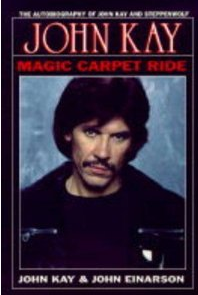 John’s autobiography in 1994. The book chronicles in great detail John Kay’s amazing journey through life. It tracks his odyssey from being born visually impaired without a father in East Prussia in the midst of World War II to become a rock and roll superstar. Magic Carpet presents an honest look at John's path through Rock ‘n’ Roll.
John’s autobiography in 1994. The book chronicles in great detail John Kay’s amazing journey through life. It tracks his odyssey from being born visually impaired without a father in East Prussia in the midst of World War II to become a rock and roll superstar. Magic Carpet presents an honest look at John's path through Rock ‘n’ Roll.
Order a copy of Magic Carpet Ride: The Autobiography of John Kay and Steppenwolf
